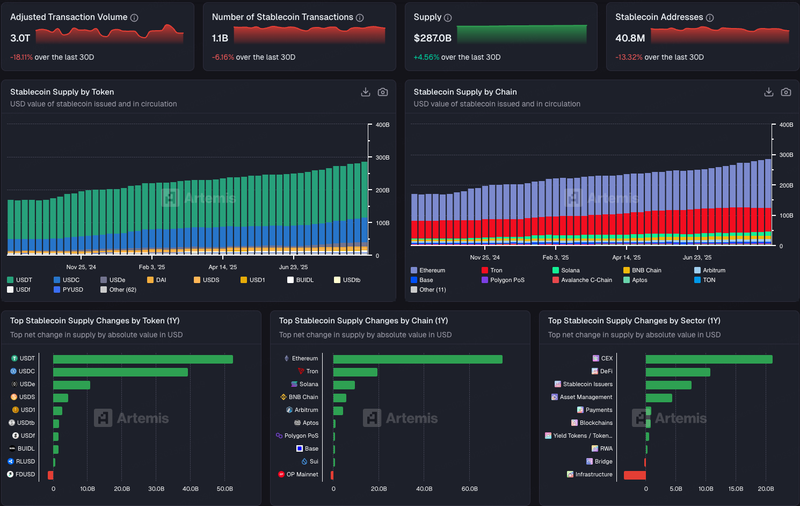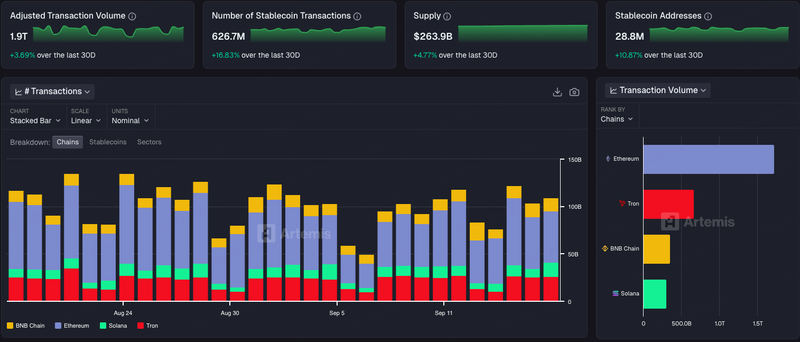BitMart Research—Stablecoin Public Chains: From Value Attachment to Value Capture

BitMart Research, the research arm of BitMart Exchange, has published a new report on the emerging trend of issuer-owned stablecoin blockchains, analyzing how major stablecoin providers like Tether, Circle, and Ethena are shifting from value attachment to direct value capture. As stablecoin transaction volumes soar—reaching over $287 billion in circulation and generating millions in on-chain fees—issuers are increasingly launching their own dedicated blockchains to reclaim lost economic upside, reduce reliance on third-party infrastructure, and enhance compliance. Projects like Tether’s Plasma and Stable, Circle’s Arc, and Ethena’s Converge are introducing stablecoin-native chains with features like zero-gas transfers, native compliance tooling, and cross-border settlement infrastructure. This report explores how these chains are poised to disrupt existing platforms like Tron and Ethereum, and why this dual-engine model—where stablecoins and blockchains converge—may define the next phase of global digital finance.
1. Current State of the Stablecoin Market
With regulatory frameworks for stablecoins gradually taking shape, stablecoins have in the past year become core infrastructure for both the crypto financial system and cross-border payments. Whether serving retail investors’ trading needs or enabling institutions in clearing, settlement, and compliance pilots, stablecoins increasingly function as “digital dollars.”As of September 2025, the total circulation of stablecoins reached $287 billion, with a highly concentrated market structure. Tether’s USDT holds roughly 59.6% of the market share (over $170.9 billion market cap), followed by Circle’s USDC at 25% ($74.2 billion). Together, the two account for nearly 85% of the market. At the same time, new entrants such as USDe, USDS, USD1, and USDf are rising rapidly into the mainstream.
The expansion of stablecoins has directly benefited underlying blockchains. In the past month alone, there were nearly 626 million stablecoin transfers on-chain, dominated by Ethereum, Tron, Solana, and BNB Chain. On Tron, for example, stablecoin transfers totaled about 69.8 million, with average fees of $0.14–$0.25 per transaction, generating $9.7–17.4 million in monthly fee revenue—all captured by the chain, not the issuer. Over time, this asymmetric value distribution has become increasingly problematic: every stablecoin transfer generates revenue for blockchains, while issuers capture almost none of it. Tron alone earns over $100 million annually from fees linked to USDT, but Tether itself sees no direct benefit.
This imbalance is pushing issuers to launch their own blockchains. Circle released Arc in 2025 with a focus on compliance and payments. Tether introduced Plasma and Stable, while Ethena launched Converge, a hybrid DeFi-compliance chain. Collectively, these moves mark the beginning of a new phase where stablecoins and proprietary blockchains jointly drive the industry, reshaping both value capture and ecosystem design.
2. Why Stablecoin Issuers Are Building Their Own Blockchains
The motivation behind issuers launching blockchains is to shift from value dependence to value capture. By controlling infrastructure, they can optimize stablecoin usage, reduce external costs, and open new business models. Key drivers include:
Reducing Dependence, Enhancing Capture
External blockchains gain from high stablecoin activity, while issuers see little incremental revenue. Proprietary chains allow issuers to retain fees and ecosystem value.Improved User Experience
Current systems require ETH, TRX, or other tokens for gas. Dedicated chains enable stablecoin-as-gas, removing the need for users to hold additional tokens.Strengthened Compliance and Institutional Access
Proprietary chains can embed compliance tools (AML/KYC, blacklists, audits), lowering barriers for banks and enterprises and improving regulatory alignment.Diversified Business Models
Beyond reserve interest, issuers can earn from transaction fees, ecosystem applications, and developer networks. For example, Arc focuses on cross-currency settlement; Stable and Plasma target payments; Converge bridges DeFi with compliance.
3. Leading Issuer-Owned Stablecoin Blockchains
Tether’s Dual Strategy: Plasma and Stable
Plasma is a Bitcoin sidechain purpose-built for payments, backed by $24M in funding from Bitfinex and Framework, with its governance token XPL valued at around $6.5B in pre-market trading. Its core strength lies in zero-fee USDT transfers, reinforced by EVM compatibility and Bitcoin’s UTXO security model. Plasma also introduces built-in privacy features and enables BTC bridging, unlocking low-slippage swaps and collateralized lending opportunities, making it a unique hybrid of Bitcoin security and Ethereum flexibility.
Stable, by contrast, is an independent Layer 1 payment chain centered on USDT as native gas, offering zero-gas P2P transfers to reduce user friction. It runs on StableBFT consensus with 0.7-second block times and instant finality, with future upgrades planned for DAG-based scalability. Fully EVM-compatible and developer-friendly with SDKs and APIs, Stable also focuses on user experience by supporting card binding, social logins, and readable addresses. Its go-to-market strategy is to leverage free transfers as an adoption driver, gradually expanding into cross-border payments, corporate treasury, DeFi micropayments, and merchant payment networks.
Arc (Circle)
Arc, developed by Circle, is a compliance-focused Layer 1 blockchain that uses USDC as its native gas and offers full EVM compatibility. It introduces a Paymaster channel enabling gas fees to be paid with other stablecoins or tokenized fiat, making transactions more flexible for enterprises. Leveraging Circle’s institutional credibility and deep ties to traditional finance, Arc provides a robust suite of tools for tokenizing real-world assets such as real estate and equities, while also supporting enterprise-grade digital payment systems. By embedding regulatory compliance into its infrastructure, Arc lowers the entry barrier for traditional institutions, offering a secure and compliant pathway into blockchain-based finance.
Converge (Ethena + Securitize)
Converge, a collaborative project between Ethena and Securitize, is designed as a hybrid DeFi-compliance blockchain optimized for RWA settlement. It achieves sub-100ms block times by integrating Arbitrum and Celestia, ensuring both speed and scalability. On the compliance side, Converge adopts USDe and USDtb (backed by the BUIDL fund) as gas assets, embedding stability and institutional trust directly into the network’s operations. Security is reinforced through a permissioned validator network (CVN) that requires ENA staking and enforces mandatory KYC/KYB, aligning its framework with the stringent requirements of institutional participants.
4. Future Outlook
In the long run, issuer-owned blockchains will challenge incumbents like Ethereum and Tron. Their stablecoin-native design—zero-fee transfers, stablecoin gas, compliance features, and institutional settlement tools—offers distinct advantages. The rapid uptake of Plasma’s staking activities underscores market appetite for such models.
That said, Ethereum, Solana, and others will remain central for innovation, complex DeFi, and open ecosystems. The likely near-term outcome is complementary specialization: issuer chains dominate payments and settlements, while general-purpose chains host broader innovation. The largest disruption risk lies with Tron, whose dominance relies heavily on USDT; if Tether migrates activity to Stable, Tron’s core advantage could erode.
Overall, the emergence of issuer-owned stablecoin chains marks a new dual-engine phase for crypto markets—combining stablecoin utility with blockchain infrastructure. This shift could reshape global payment and settlement systems, while simultaneously forcing traditional finance to reconsider its role in the evolving digital economy.
About BitMart
BitMart is a premier global digital asset trading platform with more than 12 million users worldwide. Consistently ranked among the top crypto exchanges on CoinGecko, BitMart offers over 1,700 trading pairs with competitive fees. Committed to continuous innovation and financial inclusivity, BitMart empowers users globally to trade seamlessly. Learn more about BitMart at Website, follow their X (Twitter), or join their Telegram for updates, news, and promotions. Download BitMart App to trade anytime, anywhere.
Risk Warning:
The information provided is for reference only and should not be considered a recommendation to buy, sell or hold any financial asset. All information is provided in good faith. However, we make no representations or warranties, express or implied, as to the accuracy, adequacy, validity, reliability, availability or completeness of such information.
All cryptocurrency investments (including returns) are highly speculative in nature and involve significant risk of loss. Past, hypothetical or simulated performance is not necessarily indicative of future results. The value of digital currencies may rise or fall, and there may be significant risks in buying, selling, holding or trading digital currencies. You should carefully consider whether trading or holding digital currencies is suitable for you based on your personal investment objectives, financial situation and risk tolerance. BitMart does not provide any investment, legal or tax advice.


